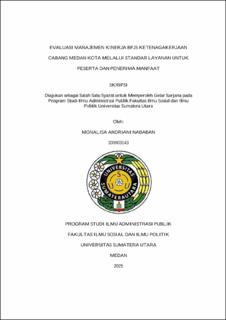Evaluasi Manajemen Kinerja BPJS Ketenagakerjaan Cabang Medan Kota melalui Standar Layanan untuk Peserta dan Penerima Manfaat
Evaluation of BPJS Employment Performance Management of Medan City Branch through Service Standards for Participants and Beneficiaries

Date
2025Author
Nababan, Monalisa Andriani
Advisor(s)
R, Siti Hazzah Nur
Metadata
Show full item recordAbstract
BPJS (Social Security Administering Body) in Law No. 24 of 2011 is a
legal entity formed to organize a social security program. BPJS Ketenagakerjaan
Medan City Branch is one of the public bodies that handles and enforces social
security for companies and workers in Medan City by providing social security
obtained by each worker which is carried out by implementing performance
management to realize organizational goals in accordance with established service
standards. This study aims to find out and describe in depth the Performance
Management of BPJS Ketenagakerjaan Medan City Branch through Service
Standards for Participants and Beneficiaries.
The research method used in this study is descriptive qualitative. Data
collection techniques used by interview, observation, and literature study. Data
analysis techniques in the form of data reduction, data presentation, and drawing
conclusions. This study uses management indicators according to George R Terry
(2012), namely Planning, Organizing, Implementation and Supervision.
The results of the study on the Performance Management of BPJS
Ketenagakerjaan Medan City Branch through Service Standards for Participants
and Beneficiaries have been carried out and attempted well but there are still
several obstacles. Reviewed from the planning indicator through the determination
of service standards, the preparation of strategies and HR planning and
infrastructure have been implemented properly in accordance with supporting the
services provided. The organizational indicator reviewed from the division of tasks
and responsibilities, HR development, and infrastructure arrangements have been
implemented but there are still obstacles in HR development which has not been
carried out properly, namely through routine training in order to improve employee
competence and ability in carrying out their work. The Implementation Indicator
has been implemented according to standards and also uses technology for service
efficiency but in claim and registration services there are still some obstacles in
timeliness which may require additional training and strengthening of
infrastructure in addition to the challenges in implementation related to service
management which requires a fast response and sometimes requires more human
resources. The Supervision Indicator has been effective, however, there are still
challenges in maintaining consistency of supervision and in resolving participant
complaints quickly, especially during peak hours which must be evaluated and
improved again.
Collections
- Undergraduate Theses [1936]
